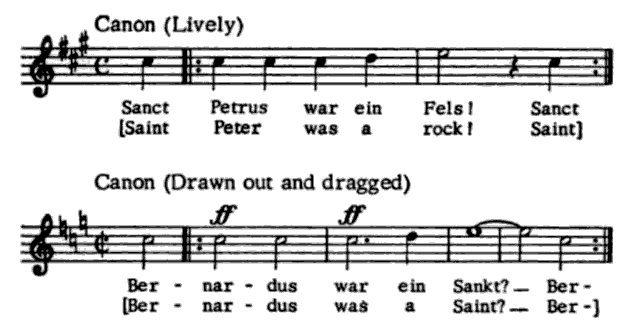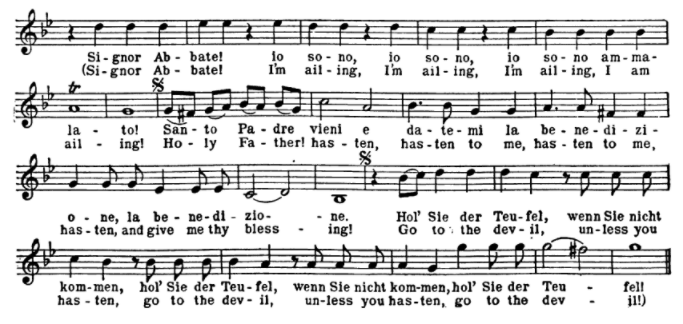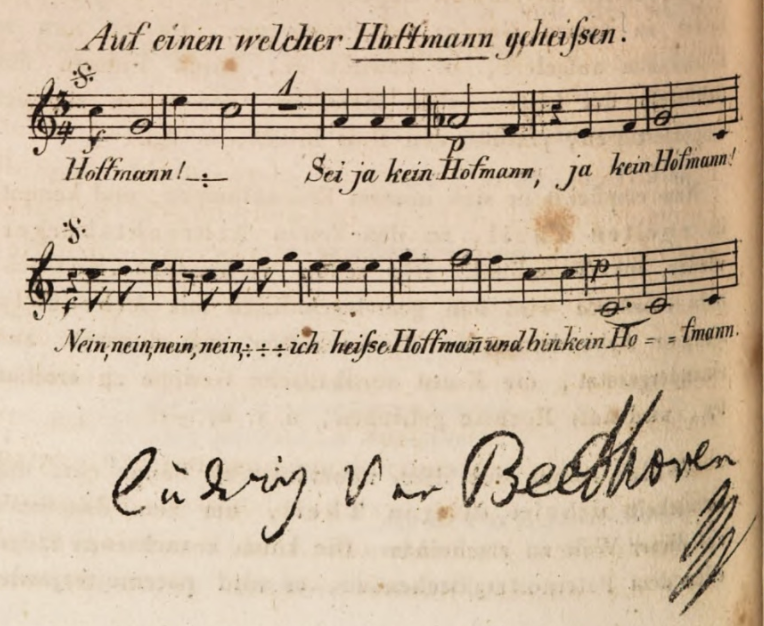After the four short canons that Beethoven composed in 1819, he wrote another six in 1820. Two of these only appear in Beethoven’s sketchbooks and have Hess numbers 300 and 301. These two are not available on YouTube, but the other four are, and one of them is quite popular.
Beethoven’s canon “Sankt Petrus” (“Saint Peter,” WoO 175) seems to date from January 1820, although there is some disagreement about that. It’s really two canons that appear in a letter (No. 1067 in Emily Anderson’s collection) and reproduced in Thayer-Forbes, p. 756:

The two “saints” referred to in the WoO 175 canon are Court Councilor Karl Peters, a tutor who was later appointed joint guardian with Beethoven of Beethoven’s nephew, and Joseph Karl Bernard, Beethoven’s librettist for a couple minor works.
#Beethoven250 Day 317
Canon “Sankt Petrus” (WoO 175), 1820
A studio recording of the two canons performed back to back.
Beethoven’s canon “Bester Magistrat, Ihr friert” (“Dear Magistrate, you are freezing!,” WoO 177) for four voices and bass, was probably written prior to April 1820 during Beethoven’s legal disputes. An autograph is available on the Beethoven-Haus site.
#Beethoven250 Day 317
Canon “Bester Magistrat” (WoO 177), c. 1820
An animation of the autograph score accompanies this studio recording.
Beethoven’s canon “Signor Abate!” has an uncertain origin. It’s generally believed to date from 1820, but Thayer-Forbes (p. 988) discusses it in the 1826 chapter and associates it with an anecdote concerning the Abbé Maximilian Stadler.

Notice the mix of Italian and German. The Italian at the beginning covers the complaint “I am ill” and a plea for a priest to come help. It switches to German for the curse “Go to the devil if you don’t come.”
Thayer believed this canon to be connected with an anecdote: Beethoven once asked the Abbé Stadler for a blessing, which was bestowed upon Beethoven while he muttered “Nutzt’s nicht, so schadt’s nix” — “If it does no good, ‘twill do no harm.”
#Beethoven250 Day 317
Canon “Signor Abate!” (WoO 178), c. 1820?
An animated score accompanies a studio performance that captures the agony of being ill while waiting for the priest to administer his spiritual cure.
The “Signor Abate!” canon has a catchy tune and is perhaps the most popular of Beethoven’s canons for live performance. What follows is a carefully culled selection.
#Beethoven250 Day 317
Canon “Signor Abate!” (WoO 178), c. 1820?
From Radenthein, Austria, the Almrose Young Voices deliver a spectacular performance.
#Beethoven250 Day 317
Canon “Signor Abate!” (WoO 178), c. 1820?
A low-key but moving rendition with young people accompanied by piano in a church in Brest, France.
#Beethoven250 Day 317
Canon “Signor Abate!” (WoO 178), c. 1820?
An elaborate five-minute live performance with orchestral accompaniment, choreography, and body percussion, from the University of Potsdam.
Beethoven’s canon “Hoffmann, sei ja ein Hofmann” (WoO 180) from March 1820 is believed to allude to E.T.A. Hoffmann, the music critic and famous writer of tales. The text is a play on the name “Hoffmann” and the word “Hofmann” with one ‘f’, the German word for “courtier.”
The pun in the WoO 180 canon disappears in the English translation: “Hoffmann, don’t be a courtier. No, my name is Hoffmann, and I am no courtier.”
#Beethoven250 Day 317
Canon “Hoffmann, sei ja ein Hofmann” (WoO 180), 1820
A studio recording with animated score.
The WoO 180 canon was published during Beethoven’s lifetime in 1825 in the 7th number of the magazine Cäcilia (named after the patron saint of music), available on the Hathitrust site.
